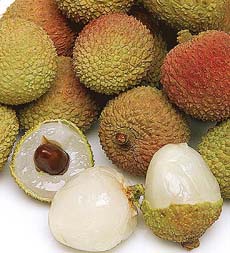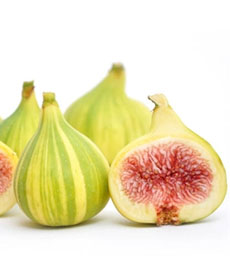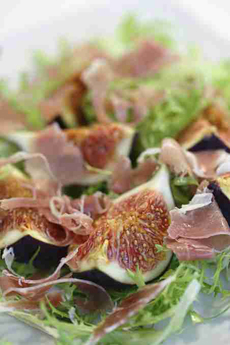|
What to look for in farmers’ markets and specialty produce stores: striped tiger figs. Or, buy them from Melissas.com.
The Tiger Fig (also called Tiger Stripe fig and Candy Stripe fig) is prized as one of the most flavorful varieties in the marketplace. It is a light yellow, small to medium, pear-shaped fig with unique dark green stripes and crimson red interior fruit. It was bred in 1668, probably from a mutation.
When fully ripe the fruit has a high sugar content and rich, jam-like texture and consistency. This taste yields a hint of strawberry or raspberry jam.
You can eat it out of hand, dry it or make preserves. But something this special looking deserves to be showcased as a dessert or cheese course.
Serve with a frisée salad.
Pair with cheeses—everything from fresh goat cheese to your favorite strong cheeses.
Make a light compote to top ice cream or cheesecake (recipe below).
Bake a delicious fig tart.
Cook with roast chicken or pork.
Slice onto a cream cheese or goat cheese sandwich on multigrain or raisin bread.
Have a green thumb? Live in the right climate (zones 5-9)? Plant your own tiger fig trees.
RECIPE: FRESH FIG COMPOTE
If the figs are very sweet, you may need only a scant amount of sweetener. You can use the compote as a bread spread and a condiment with sweet or savory foods.
Ingredients For 2/3 Cup
1 pound fresh figs
1 to 6 tablespoons sugar or honey (or half as much agave)
1/2 cup water
1/4 to 1/2 teaspoon cinnamon
Preparation
1. REMOVE the stems from cleaned figs and cut into quarters. Place figs, sweetener, water and cinnamon in a small saucepan over low heat.
2. COOK for 30 minutes, stirring occasionally. Remove from heat and stir in butter.
3. PULSE, using an immersion blender or food processor, until desired consistency is reached. Store in an airtight container in the fridge.
FIG FACTS
Figs do not ripen off the tree, so buy those that are soft to the touch. The skin around stem should have begun to twist and wrinkle.
Along with olives and grapes, figs are believed to be among the first fruits cultivated by man. Native to Western Asia (the Middle East and the Near East), Ficus carica has been cultivated for more than 5,000 years.
|










